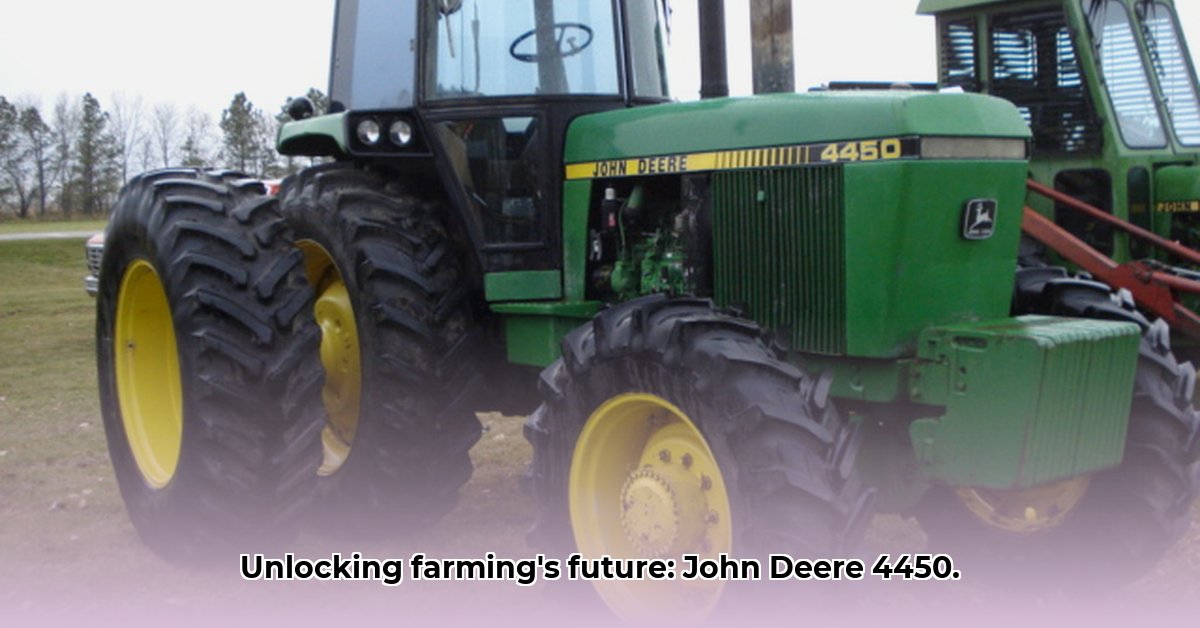
The John Deere 4450 tractor: a name synonymous with reliability and power for generations of farmers. This article explores the 4450's historical significance, its innovative features, and how it stacks up against modern agricultural machinery. We'll analyze its strengths and limitations, offering insights into its lasting impact on farming practices. For more information on older John Deere models, see this helpful resource.
A Technological Leap in its Time
Launched decades ago, the John Deere 4450 represented a substantial advancement in agricultural technology. Its groundbreaking Caster/Action front-wheel-drive system (a system improving traction and maneuverability, especially in challenging terrain) significantly enhanced maneuverability and efficiency in the field. Farmers experienced improved control, especially in navigating tight spaces or uneven ground. This wasn't just about convenience; it translated to faster and more efficient fieldwork. The 4450's robust engine, delivering a tested 120.11 horsepower at the drawbar and 158.2 peak horsepower, provided ample power for diverse farming tasks—from plowing to hauling heavy loads.
Did you know that the 4450 offered a choice between a 15-speed full power shift and a 16-speed partial power shift transmission? This versatility allowed farmers to precisely match the tractor's power to the specific demands of each job, optimizing performance and minimizing fuel waste. This level of adaptability was a remarkable achievement for its era, setting a new benchmark for farm tractors.
Comparing the 4450 to Modern Tractors
Modern agriculture relies heavily on GPS-guided systems, automation, and advanced technologies not present in the 4450. Today's tractors are essentially smart machines, offering precise planting, automated spraying, and fuel-efficient designs. The 4450's 65-gallon fuel tank, sufficient for its time, contrasts sharply with the fuel efficiency improvements of modern tractors which reflect both environmental concerns and economic considerations. The emission standards of the 4450's era are vastly different from today's stricter regulations, a critical distinction when assessing environmental impact. In essence, while the 4450 was a powerhouse in its day, modern tractors offer significant advancements in precision, efficiency, and environmental responsibility. It's a similar comparison to comparing a classic car to a modern electric vehicle. Both serve a purpose, but the efficiency and experience differ drastically.
The Enduring Legacy of the 4450
Despite the technological leaps in modern agricultural machinery, the John Deere 4450 continues to hold a special place in farming history. Its durability and reliability have ensured its continued use on many farms. The strong aftermarket support, with readily available parts and service, contributes significantly to its ongoing relevance. This speaks volumes about the quality of its original design and construction. The 4450’s prolonged operational life demonstrates the enduring value of robust engineering and a well-built machine. Many farmers appreciate the workhorse nature of this tractor and appreciate the simplicity and reliability in comparison to more advanced models.
Insights for the Future: Learning from the Past
The John Deere 4450's design and operational data offer invaluable insights for agricultural engineers and researchers. Analyzing its strengths and weaknesses informs the design of future tractors, leading to improvements in efficiency and sustainability. By studying the 4450, researchers can refine elements such as power-to-weight ratios, transmission designs, and overall operational efficiency. The 4450's legacy isn't just about its own performance; it's about the continuous improvement it inspires in modern agricultural technology. Can we learn from the 4450's simpler design to create more environmentally friendly and accessible tractors today? Yes. This is a key avenue of research.
Stakeholder Perspectives on the 4450's Continued Relevance
The John Deere 4450's legacy extends beyond the farm itself. Its impact resonates throughout various sectors:
- Farmers: Farmers utilizing 4450s must balance the machine's operational costs with its current efficiency, exploring ways to maximize its productivity and minimize its environmental impact. Long-term, upgrading to newer technology is an important consideration dependent on the financial and logistical factors specific to each farm.
- Equipment Dealers: These dealers must maintain a supply chain to support 4450 owners while also adapting to emerging technologies in their service offerings. To meet this, training technicians on newer equipment and modernizing services is now a key business priority.
- Agricultural Researchers: Researchers look to the 4450's data to unearth key performance indicators and evaluate potential design improvements. They focus on areas like fuel efficiency, emission reduction, and overall operational performance and sustainability.
- Agribusinesses: These businesses focus on optimizing the productivity of farms using 4450s by identifying and addressing efficiency gaps. Long-term, they must integrate contemporary, more sustainable farming procedures into their business models.
- Policy Makers: Policymakers can support farmers through educational programs focusing on modern agricultural technologies. Creating incentives to adopt sustainable and efficient farming practices is crucial for the future of agriculture.
The John Deere 4450 tractor stands as a testament to engineering prowess and the dedication of farmers. While advancements continue in farm machinery, the 4450's story serves as a valuable reminder that learning from the past is integral to shaping a more sustainable and efficient agricultural future.